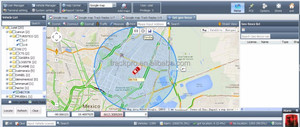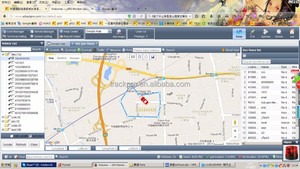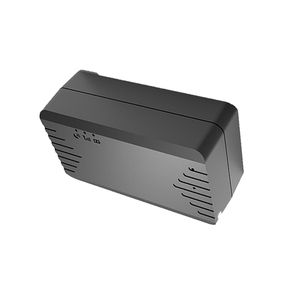(1608 products available)























































































































 Ready to Ship
Ready to Ship

























































































Online GPS locations can be divided into two categories based on functionality: real-time tracking GPS and non-real-time tracking GPS.
Real-time tracking GPS
Real-time tracking GPS is a system that can track and provide information about the location of an object in real-time. The GPS receiver on the tracked object continuously receives signals from satellites and sends the location data to the control center through the communication network. Meanwhile, the system can also provide the movement speed and direction of the object. The information is displayed on the computer screen in real time, and the operator can observe the object's movement track on the map at any time. In addition, the system can set up multiple management and alarm functions, such as exceeding the fence, moving speed exceeding the threshold, and equipment failure alarm. Therefore, real-time tracking GPS can track the location and movement state of the object in real time and provide accurate information for logistics management, transportation safety, and other fields.
Non-real-time tracking GPS
Non-real-time tracking GPS, such as GPS loggers and personal locators, can track location information but cannot provide real-time location information. The device will record the user's location information over time, which can be retrieved and analyzed later. This is helpful for logistics tracking, historical data analysis, and safety monitoring.
The specifications of GPS devices are tailored to meet the needs of different target audiences. Below are some common GPS specifications.
GPS Accuracy
GPS accuracy refers to how closely a user's actual location matches the location data provided by the GPS. High accuracy means the GPS can pinpoint the user's location precisely, while lower accuracy means the location data may be slightly off. Accurate GPS is important for precise navigation and location tracking.
Screen Size
Screen size refers to the dimensions of the display on the GPS device. A larger screen makes it easier to see maps and navigate, while a smaller screen may be more compact but harder to read. Screen size affects the usability of the GPS for viewing directions and navigating routes.
Battery Life
Battery life indicates how long the GPS can be used before it needs to be recharged. Longer battery life allows for extended use during travel or outdoor activities without frequent charging. Shorter battery life may require regular charging, limiting the GPS's usability over time.
Map Updates
Map updates ensure the GPS has the latest information on roads and locations. This is important because new routes, closures, or changes can affect navigation. Users can get updated maps through subscriptions or downloads, keeping the GPS accurate for travel planning and directions.
Size and weight
Size and weight are important for a GPS tracker for car location, as smaller, lighter devices are often more convenient to carry and less noticeable when tracking. Compact size and low weight make it easier to incorporate the GPS into everyday life without drawing attention to the tracking.
Durability
Durability is a key online GPS feature. It ensures that the device can withstand harsh conditions, including extreme temperatures, moisture, and dust. A durable GPS remains functional in various environments, making it reliable for navigation and tracking in different weather and outdoor situations.
Online GPS location services make it easier to track locations and navigate. However, like any technology, there can be issues with GPS. Here are some tips on how to maintain a good online GPS location.
Choosing the right GPS technology for a business depends on various factors. Here are some of them:
Coverage and availability
Businesses should consider the availability of GPS signals in their area. Some regions are prone to GPS signal interference, such as urban environments with tall buildings or remote locations.
Accuracy and precision
Different GPS systems offer varying accuracy levels. Businesses that rely on precise location information, such as delivery services or field service companies, should choose online GPS locations with high accuracy and precision.
Real-time tracking and updates
Businesses require real-time location information for many applications, including fleet management, asset tracking, and logistics optimization. It's important to choose an online GPS location that provides real-time tracking with location updates.
Integration with existing systems
Businesses should consider how GPS location services integrate with their existing systems. For instance, they should check if it connects with their dispatch software, logistics management systems, or mobile applications.
Security and reliability
Businesses rely on GPS for critical operations. Therefore, they should ensure the online GPS location they choose is safe and reliable. They should also have backup systems to handle GPS signal outages or disruptions.
Customizability and Scalability
Businesses should consider whether the chosen GPS location is customizable to their specific needs and is scalable to accommodate future growth. It should offer various tracking options, such as vehicle tracking, asset tracking, or employee tracking, and should be able to handle increased tracking requirements as the business expands.
DIYers need to have the right tools and equipment for the job. Below is a list of tools needed for an online GPS location DIY project:
Once the tools are acquired, follow the steps below to replace or fix an online GPS location:
Once the problem is identified and fixed, DIYers can test the GPS by checking the location map to see if it shows the correct location. They can also use the GPS to navigate to a known location and see if the location accuracy is improved.
Q1: What are the benefits of having an online GPS location?
A1: Users can access real-time updates, navigate accurately, and track assets or pets through the online GPS location. It is beneficial for logistics, emergency services, and outdoor activities. It also has location-based services like weather, traffic, and local search information.
Q2: Is an online GPS free to use?
A2: Users can access online GPS for free through services like Google Maps. However, some advanced features, such as commercial GPS for fleet tracking, require a subscription and payment. Additionally, some services may offer more features and fewer ads for a fee.
Q3: How does an online GPS location work?
A3: An online GPS location uses signals from satellites received by GPS-enabled devices. The device calculates its distance from multiple satellites to determine its precise location, which is displayed on a map. It combines satellite data with internet data to provide location information.
Q4: Is an online GPS location accurate?
A4: Generally, an online GPS location is accurate within 5 to 10 meters. However, factors like satellite availability, signal interference, and environmental conditions can affect accuracy. Obstructions like tall buildings or trees can block signals and reduce precision.
Q5: What are the requirements for using an online GPS location?
A5: Users need a GPS-enabled device, like a smartphone or tablet, an internet connection, and access to a GPS service. Some services require an account. A compatible web browser is also necessary to access online GPS services. Some applications may need additional hardware for precise locations.